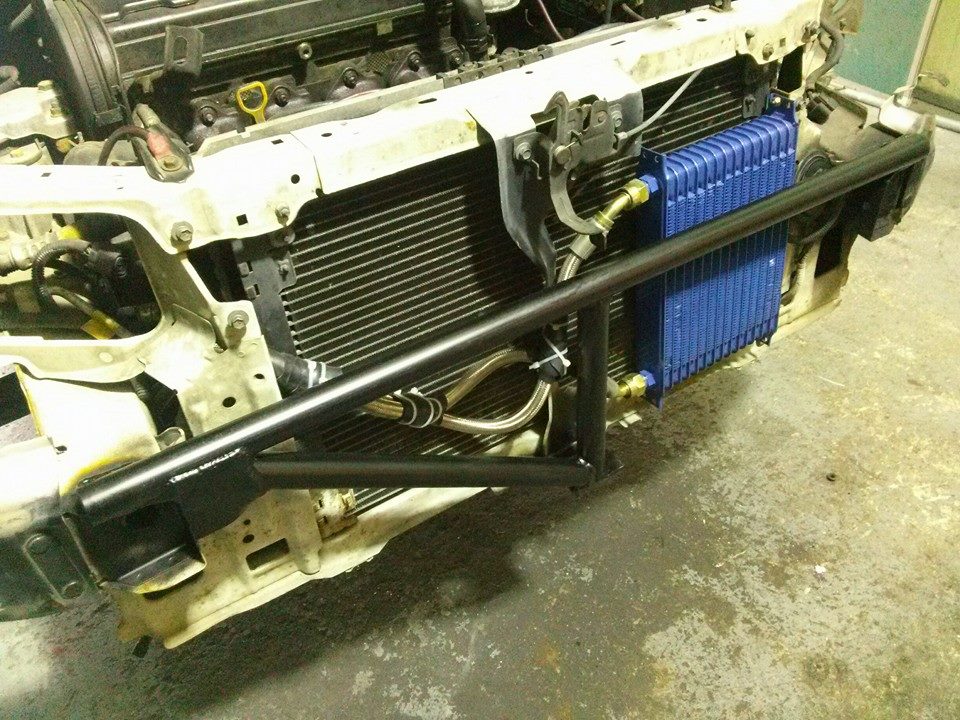This story begins with a routine visit to my friends at Turbo Spark. First, I planned to build some air ducts that that I might improve the efficiency with which my pile cools its engine and sticks to the ground. Second, I intended to complete a previously done rust repair.
The air ducts would be my first experience with fiberglass and so, in preparation, I brought along everything I would need except a mold. A quick rummage through the garbage yielded a Styrofoam tray that, from the left over packaging, had once served to contain 532 grams of diced pork leg. Well pleased, I cut this in half and laid out the glass fibers. With a little help from my roll of transparent packing tape, these actually came out looking remarkably like air ducts.

Half of what used to be packaging for some pork I'd cooked a week before. You have to cover this stuff with tape or the resin will dissolve it.

Here you can see the glass sheet and the resin. Do not breath the fumes.
 Applying more resin.
Applying more resin.
We ended up using three alternating layers of glass and resin. We left it overnight and were rewarded with a very strong, solid piece the next day.
Some quick notes on fiberglass. The resin is made from some of the nastiest stuff on earth. Do not let it touch your skin or anything else you are uncomfortable throwing away. It is noxious, seriously sticky, able to dissolve rubber (and skin) and perfectly happy to bond with your concrete driveway to such extents you will need a pick axe to remove it. The sheets of glass fiber are almost as nasty. Try not to touch them with your bare skin, wear long sleeves and do not breath the dust unless you're curious about how asbestos poisoning feels. In other words, use caution with this stuff.
But for all these problems, fiberglass is insanely easy to fabricate with. I'm going to make a new hood next time, after that some fenders and probably a trunk. Your own creativity is really the only limit when it comes to fiberglass shapes.
Now, the activity most likely to take over and ruin my life - rust repair. Before this weekend my Nubira had been the recipient of two new rear shock towers (both rusted through), two enormous patches on the drivers side sill, a new front fender and a section of trunk. Sunday, as I got the car up on a lift - thanks Turbo Spark for letting me use the shop - I discovered six new rust holes in the passenger side sill.
 The enormous patches on the driver's side.
The enormous patches on the driver's side.
 After a little finishing
.
After a little finishing
.
 Surprise! More rust on the passenger's side.
Surprise! More rust on the passenger's side.
I could have bought sheet metal and patched them at moderate expense a few weeks later but that is a fool's errand with one so skilled in ghetto fab as I. No, I would walk into the remains of a mostly demolished building next door, strip the steel from a large insulation panel and cut that up for strips. The only problem was that this insulation panel had been filled with plastic foam pellets, a million or so of which stuck to the metal.
 You may call this a demolished building, I call it a shopping opportunity.
You may call this a demolished building, I call it a shopping opportunity.
 The prize!
The prize!
I had planned to fix this with the help of a butane torch, but the shop owners were not as tolerant of noxious fumes as was I and compelled me to stop before salvaging the entire 3 meters of metal. This was a bummer in that I'd planned to make a front half flat bottom with the remainder, but not so bad in that I'd already burnt enough away to make my passenger's side patches.
 Viola, rust patch for the passenger's side.
Viola, rust patch for the passenger's side.
 And the other one.
And the other one.
Given the absolute lack of investment and mostly salvaged materials, I think this is turning out pretty well. I cleaned out all the internal rust, made sure the frame rails are intact - they're fine - and reopened the clogged drain holes. The only remaining rust I know about is on a fender I plan to trash this weekend anyway. Some bondo and a fresh coat of paint and I'll bet nobody notices that 10% of my car is made from butchered thermal panels.






 On the upside, this is the first time I've taken a chunk of my car apart and not found rust. On the downside, I did find crash damage.
On the upside, this is the first time I've taken a chunk of my car apart and not found rust. On the downside, I did find crash damage.
 Redoing the oil cooler lines so they don't abraid. Got the rubber from a gardening supplies store and used it to both separate the two lines and protect anything they might rub on.
Redoing the oil cooler lines so they don't abraid. Got the rubber from a gardening supplies store and used it to both separate the two lines and protect anything they might rub on.
 More oil cooler routing stuff.
More oil cooler routing stuff. 



 Fenders are for the weak.
Fenders are for the weak.  Chan-sik strategically blocking the pornographic newspaper cartoon.
Chan-sik strategically blocking the pornographic newspaper cartoon. The brown fender and white fender are, here, united in a new black color scheme.
The brown fender and white fender are, here, united in a new black color scheme. 
























